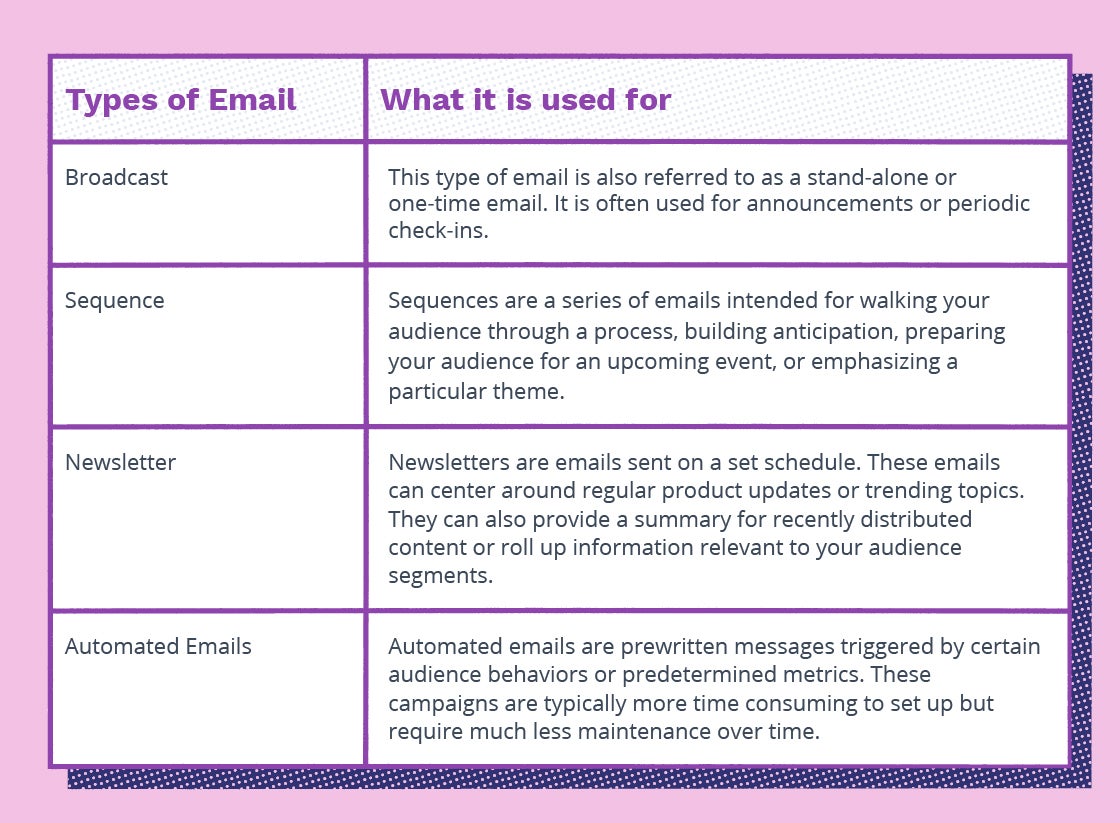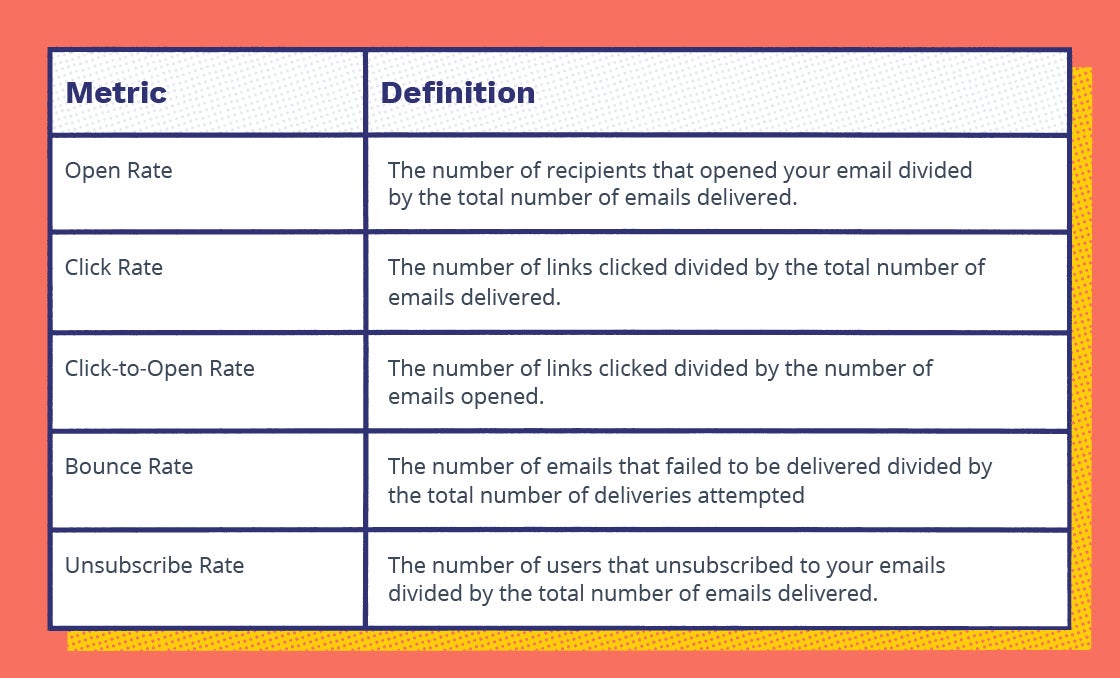So far, we’ve covered a lot of ground (if you haven’t yet, check out Email Marketing 101: Audience Building and Email Content). We discussed building an audience, creating segmentation, and also outlined best practices for putting your email together.
Next in line is how to launch your campaign, analyze results, and maximize your performance.
On how to build your audience and email content:
Launching Your Campaign
There are a few different ways to structure your email sends. Determining which one to use is essential to the outcomes you’re hoping to drive.
Types of emails
Much like selecting a mode of transportation, you wouldn't take a jet plane to the grocery store or ride a skateboard cross country.
So, when launching your email, how do you marry your method of delivery with your campaign's objectives? Here are the most common types of emails and when to use them. Their varying purposes allow you to take a holistic approach when communicating with your audience:
![]()
Maximizing Performance
Once you’ve crafted the perfect email and selected the delivery method, you may be interested in finding other ways to improve your campaign's performance. Go no further!
With each email you send, you're going to learn a lot. From finding your voice to determining the topics your audience is most interested in, you'll continuously find ways to better engage your audience. You'll also likely discover that a single communication channel may not be enough to generate awareness and drive intended outcomes. Remember, we only have eight seconds to leave an impression.
Imagine for a moment that we only had one opportunity to catch the name of a song we really liked, or a few moments to absorb the details of a complicated explanation. The human brain is designed to forget about things from time to time.
What’s that 18th-century proverb? “If at first, you don’t succeed, try, and try again.” As marketers, we have to leverage repetition to help get our point across. That means that a successful email campaign should probably include more than just...email.
So, which tools should you focus on? Here are several things you should consider as you’re trying to make the most of your message.
Leveraging advertisements and email retargeting
For the more critical email campaigns, an often-used performance maximizer is paid advertisement. This marketing activity can help to emphasize a theme, tap into a seasonal promotion, or encourage sign-up.
There are a couple of different ways to use ad campaigns to enhance your email strategy. The first is to start with advertisements and then to email those who visited your site. The great thing about this technique is that you can engage both known and unknown populations, the latter potentially driving increased brand awareness and sign-ups.
Another option is to start with emails to known populations. As a follow-up, you can target the audience you messaged with retargeted advertisements. The benefit of this is that you can isolate those who opened your email or those who expressed interest by clicking on your call-to-action (CTA). This can be a less expensive route if your audience is typically engaged and simply needed a well-placed reminder.
Brands that maximize email with complementary advertising and retargeting strategies have often seen a substantial increase in their return on investment (ROI). BustedTees is one of these brands, realizing a 390% return on investment as a result of a unified email marketing and paid advertisement campaign.
Complementing email with onsite messaging
Similar to the advertising route, reinforcing your email campaign with onsite messaging helps to recall the message and remind your audience of the actions they need to take. Onsite messages can be used in lots of different ways. Here are a couple of strategies that you might leverage to maximize your email performance:
- Leverage a discreet pop-up to highlight an email exclusive coupon. It isn’t just about receiving a coupon — it’s receiving a coupon at the perfect moment, just before you’re about to make a purchase decision. Reminding a customer with a pop-up that they have yet to apply that coupon might be just what it takes to get them to convert.
- Reference your recent email as part of an audience survey. Do you ever notice that sometimes it takes a well-timed question to heighten your senses and get you to pay attention to your surroundings? Sometimes a simple survey question on your website underlines a key message in your email or a piece of content that you wanted to draw attention to:
Hey there! Did you happen to read this month’s newsletter about optimization? How helpful did you find our personalized tips?
If you’re looking for software to help manage onsite messaging, here are a few that we would recommend you check-out: Pendo.io, UserIQ, Quickblox, AppCues
Analyzing Results
Remember how we talked about the importance of creating an audience checkbox for each step you take? Analyzing results is another one of these steps that will get you closer to your audience if you put them first.
To ensure that your performance is as predictable as possible, we recommend gathering all of the data you can get your hands on. With most email marketing tools, this shouldn’t be a problem — these solutions are typically set up with reporting features to help you understand how your emails are doing.
As you're reviewing this data, it's also essential to have a clear understanding of your primary objective. That's objective — singular.
When you’re getting started with email marketing, there’s often the temptation to address every opportunity that stands before your brand with a single email campaign. We’ve found it much more effective to operate with a unified objective to maintain focus and accurately measure impact.
This one objective you identify can represent a few areas of growth. Maybe your objective is as simple as readership retention. Many brands focus on the number of sign-ups they can drive or the sales volume they can produce.
Whatever your objective ends up being, making sure you analyze your email's contribution to this objective is critical. The exercise output will help you develop new ways to structure your content and orient your strategy.
To help make this process more intuitive, we've outlined some of the different metrics we analyze to gauge customer interest and email performance.
Vanity metrics
Vanity metrics represent measurements that offer some insight into the success of your email campaigns. Here are the more common vanity metrics used to measure performance:
![]()
Are You Ready to Put Your Email Marketing Campaign Together?
In Email Marketing 101: Audience Building and Email Content and this post, we covered each of the fundamentals associated with building an effective email marketing strategy. Email is a powerful tool that will help you share your story and grow your brand.
As you get started, take the tips of these guides to heart. By making a concerted effort to speak directly to a well-crafted audience, produce content that’s professional, concise, and value-driven, and to measure the performance of these messages frequently, we’re confident that your email performance will reach great heights.
Your email marketing journey doesn't stop here — learn the perfect email cadence for your audience.
Last updated on April 23rd, 2025.


